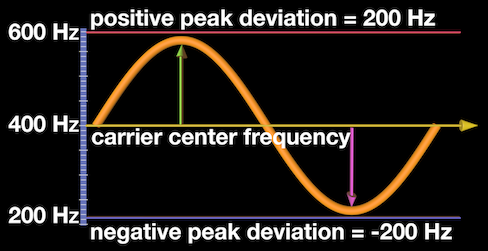Chapter Four: Synthesis

8. Principles of Audio-rate FM Synthesis | Page 4
Computer Sideband Strength via the Modulation Index
As with ordinary complex waveforms, the timbre perceived by the listener is determined not only by the frequencies present, but also by their relative strengths, and in some cases, their phase. The upper and lower sidebands of each sideband pair have the same strength.* In order to calculate the strength of each sideband pair relative to the others, we first must look at the main determining factor. As we have seen above, when the carrier is modulated, its frequency rises and falls with the amplitude of the modulating wave. The greater the amplitudes of the modulating wave are at its peaks, the greater the maximum distance the carrier is pushed off its center frequency. At sub-audio rate, we would perceive this as the depth of a vibrato. When using a pure sine wave and linear modulation, these peaks will be an equal number of Hz above and below the carrier's center frequency. The number of cycles above or below the center frequency is called the peak deviation (or p.d., or delta (Δ) ƒ). As the amplitude of the modulating wave is increased or decreased by some means, perhaps using an envelope generator/amplifier pair shown here, so too does the peak deviation change. It is this parameter, the changing strength of the modulating wave, that allows us to create dynamic, time-varying spectra of a sort very different from subtractive filtering, and one that can, under certain circumstances, mimic the complexity of real-world sound characteristics using only two oscillators. As the figure below indicates, peak deviation is measure only from the center frequency to either the positive or negative peak, not peak to peak!

To compute how the strength of the sideband pairs and how they may change change over time as the strength of the modulating wave is varied, we divide the peak deviation by the modulating frequency to produce a value called the modulation index, or simply I.

If none of the modulating wave is permitted to reach the carrier, the peak deviation and the value of I will be zero, since no modulation is taking place. As the amplitude of the modulating wave increases, the carrier is pushed farther and farther off its center frequency and the value of I also increases. The effect of an increasing I is different for each sideband pair. In our first formula for predicting sideband frequencies, we used all the integer values of n (Cƒ ± nMƒ). A sideband pair calculated with a particular value of n can be called a pair of the nth order.
*Because our hearing is more sensitive in mid- and upper-range frequencies, this equality of sideband power can cause FM timbres to sound more weighted to the higher frequencies.